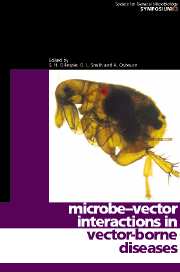Book contents
- Frontmatter
- Contents
- Contributors
- Editors' Preface
- 1 Vector-borne diseases
- 2 Evolution of tick-borne disease systems
- 3 Insect transmission of viruses
- 4 RNA-based immunity in insects
- 5 Specificity of Borrelia–tick vector relationships
- 6 Bunyavirus/mosquito interactions
- 7 How do mosquito vectors live with their viruses?
- 9 Vector competence
- 9 Environmental influences on arbovirus infections and vectors
- 10 Vector immunity
- 11 Transmission of plant viruses by nematodes
- 12 Wolbachia host–symbiont interactions
- 13 Pathogenic strategies of Anaplasma phagocytophilum, a unique bacterium that colonizes neutrophils
- 14 Interactions of Yersinia pestis with its flea vector that lead to the transmission of plague
- 15 Transgenic malaria
- 16 Vaccines targeting vectors
- Index
3 - Insect transmission of viruses
Published online by Cambridge University Press: 06 July 2010
- Frontmatter
- Contents
- Contributors
- Editors' Preface
- 1 Vector-borne diseases
- 2 Evolution of tick-borne disease systems
- 3 Insect transmission of viruses
- 4 RNA-based immunity in insects
- 5 Specificity of Borrelia–tick vector relationships
- 6 Bunyavirus/mosquito interactions
- 7 How do mosquito vectors live with their viruses?
- 9 Vector competence
- 9 Environmental influences on arbovirus infections and vectors
- 10 Vector immunity
- 11 Transmission of plant viruses by nematodes
- 12 Wolbachia host–symbiont interactions
- 13 Pathogenic strategies of Anaplasma phagocytophilum, a unique bacterium that colonizes neutrophils
- 14 Interactions of Yersinia pestis with its flea vector that lead to the transmission of plague
- 15 Transgenic malaria
- 16 Vaccines targeting vectors
- Index
Summary
INTRODUCTION
Obligate parasites all rely on their host for survival. Transfer from one host to another is thus a key aspect of their life cycle, ensuring both their maintenance (vertical and horizontal transmission) and spread (primarily horizontal transmission) in the environment. Vertical transmission, i.e. the passage of a parasite directly from one host to its descendant(s), is a strategy that does not involve passage outside the host, and so maintains the parasite in an amiable environment. However, the success of this transmission strategy depends on the survival of the host line. Furthermore, it restricts parasite spread within the host population. In fact, the survival of the parasite population is directly related to host fitness. Thus vertical transmission may be expected to lead to parasite populations with lower virulence or to non-pathogenic interactions (Frank, 1996; Day, 2001; Weiss, 2002).
All pathogens have evolved additional (or even exclusive) strategies for horizontal transmission, with an impressive diversity of mechanisms that will be the focus of the present chapter. Pathogens are found among viruses, bacteria, fungi, protozoa and metazoa but the tremendous richness of transmission strategies mentioned above is certainly best illustrated by viruses. Examples of horizontal transmission of organisms other than viruses are described in several sections of this symposium volume. Some viruses have, like other pathogens, developed the ability to transfer from infected to healthy hosts by contact or through passage in the external medium, via a variety of propagating forms (Kuno, 2001). Most viruses, however, exploit an additional organism, itself travelling from host to host, as a transportation device (referred to as a vector).
- Type
- Chapter
- Information
- Microbe-vector Interactions in Vector-borne Diseases , pp. 43 - 62Publisher: Cambridge University PressPrint publication year: 2004
- 3
- Cited by



